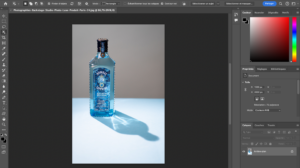Common Retouching Tools and Features
In this article :
In the world of photo post-production, retouching is much more than a simple image correction. The common tools and features form the essential framework that allows creatives to transform a raw photograph into a stunning visual. These tools make it easy to adjust parameters, correct imperfections, and express artistic intent, offering great creative freedom. This field encompasses various techniques, ranging from basic exposure adjustments to more complex manipulations like HDR blending, and seamlessly integrates into the retouching universe.

A Range of Tools to Enhance Every Image
The diversity of retouching tools allows an image to be approached from multiple angles. For example, exposure adjustment is often the starting point, correcting areas that are too light or too dark. Mastering this tool provides a solid foundation for the rest of the work.
Beyond this first step, curves offer a refined method for adjusting contrast and brightness at different levels of the image. This powerful tool helps add depth to shadows and subtly illuminate highlights.
In the daily work of professionals, the tools and features integrated into retouching software prove indispensable. They offer a range of intuitive adjustments that make the creative process more accessible, even for beginner users. For example, functions like cropping allow for a more harmonious composition by re-centering the image, while techniques like dodge & burn enable playing with light to create depth and emphasize specific details.
Advanced Techniques and Tips for Precision Retouching
When it comes to delving deeper into image work, certain advanced techniques stand out for their effectiveness. Frequency separation is one such method, allowing textures and tones to be isolated, refining corrections without affecting fine details. This is particularly useful for retouching portraits or images with superficial imperfections.
Another essential tool is the layer mask. Used to preserve and apply localized adjustments, it provides precise control over specific areas of the image. Additionally, cloning and the healing brush are crucial for removing unwanted elements and restoring damaged areas without leaving traces.
Among other popular features, the vignette effect adds an artistic touch by darkening the edges of the image, directing attention to the central subject. Similarly, white balance is crucial to ensure that colors remain natural and consistent, particularly in varied lighting environments.
In addition, techniques like dodge & burn allow for enhancing light and shadow on specific parts of the image, giving the final visual more dimension. For projects requiring an extended dynamic range, HDR blending is also a highly effective solution, combining multiple exposures to achieve a balanced result rich in detail.
Integration into the Post-Production Workflow
These tools and features are not used in isolation; they are an integral part of the overall photo post-production process. In this environment, each step is carefully orchestrated to ensure that the final image perfectly aligns with the creative vision. Basic adjustments, such as exposure settings and cropping, are combined with advanced techniques like frequency separation and HDR blending to deliver a polished result.
At the heart of this workflow, retouching is the phase that ties all these techniques together. It allows for fine-tuning the image by making precise corrections and harmonizing all visual elements. It is in this context that the importance of common tools and features becomes evident, providing professionals with a complete palette to express their creativity.
Towards Mastery of the Art of Retouching
The constant evolution of technology has allowed for the integration of more intuitive interfaces and automated features in retouching software. These advancements make mastering tools and features more accessible while still allowing for manual adjustments to achieve custom results.
In this context, specific techniques such as exposure adjustment, curves, and cropping are commonly used to enhance the composition of an image. Additionally, the use of layer masks or cloning allows for targeted corrections without compromising the overall quality of the photo.
These technical approaches, enhanced by proven tips and tricks, transform retouching into a true art form that allows creatives to push the boundaries of their visual expression. The combination of these tools provides flexibility and precision that make all the difference in producing high-quality images.
Conclusion
Common tools and features form the foundation of successful retouching, enabling the transformation of raw images into captivating visual works. They naturally integrate into the overall post-production process and the art of retouching, offering endless possibilities to correct, enhance, and personalize every detail of an image. Thanks to these tools, techniques such as exposure adjustment, curves, cropping, as well as more advanced methods like frequency separation, dodge & burn, and HDR merging become accessible and essential for creating visuals that make a lasting impression.
By mastering this toolkit, each creative can truly harness the potential of their images, thereby enhancing visual communication and reinforcing brand identity.
Jérémy Carlo is the editorial director at Rétines, where he ensures the consistency and clarity of all content produced by the studio.
Our Clients
Let’s discuss
What we do for you at Rétines
Meticulous work, an organised project and fast delivery. And to achieve this, we mobilise the right resources in our teams at the right time.
01
Pre-production
Artistic and technical direction tailored to the project.
Relevant recommendations on content, form and resources.
02
Photo Shooting
Photos taken by our experienced photographers.
Production that’s controlled, efficient and tailored to the needs of the project, with nothing superfluous.
03
Retouching
Technique
Photographs magnified by our retouching team.
Post-production to meet the commercial challenges of the brief.












